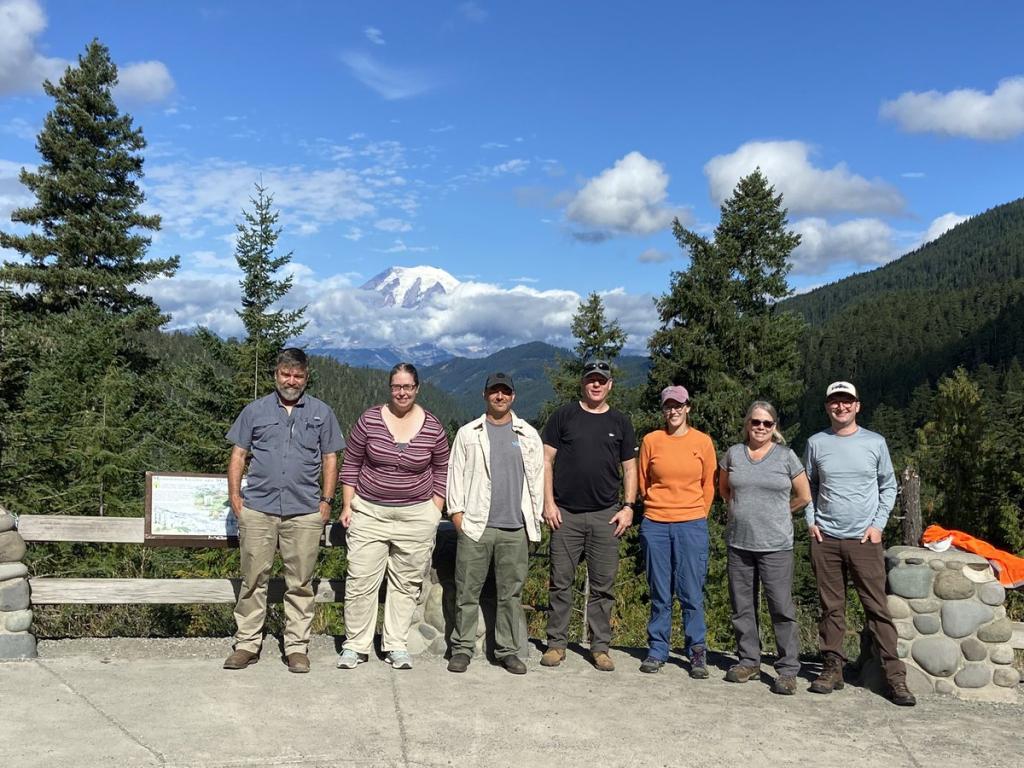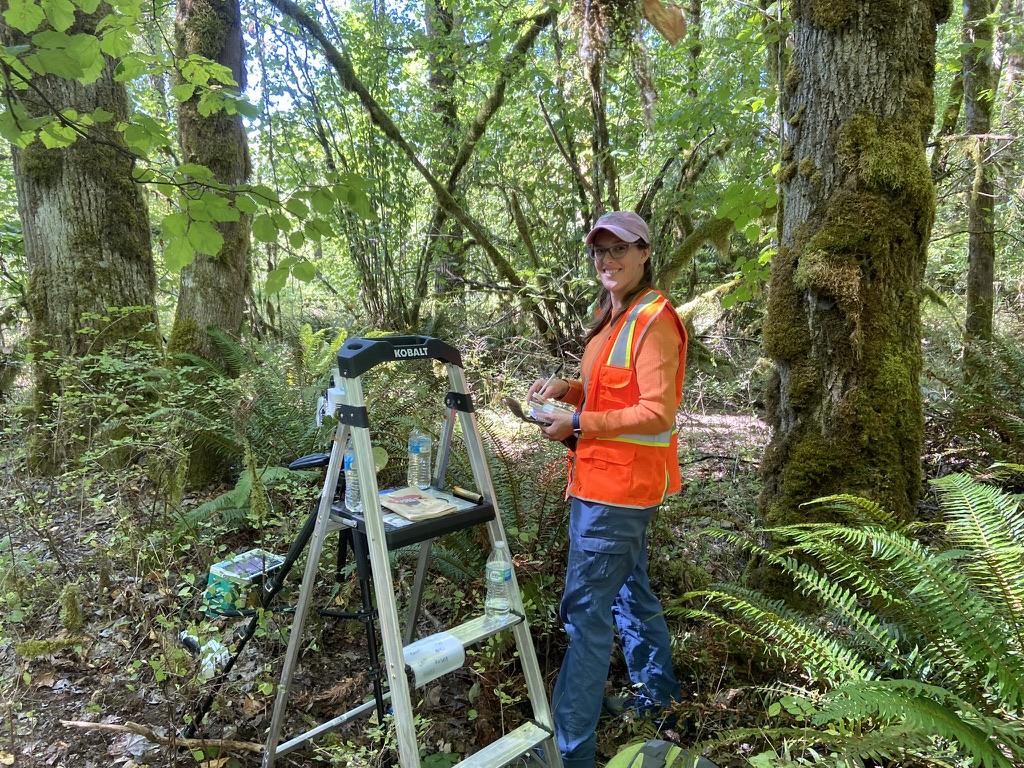
When the Department of Energy's Oak Ridge National Laboratory science mission takes staff off-campus, the lab's safety principles follow. That's true even in the high mountain passes of Washington and Oregon, where ORNL scientists are tracking a tree species - and where wildfires have become more frequent and widespread.
For the past three years, ORNL environmental microbiologist Chris Schadt has been leading field work in the Cascade mountains on the characterization of wild Populus trichocarpa - a fast-growing poplar tree that scientists want to improve as a bioenergy crop.
Schadt and ORNL colleagues take samples from branches, leaves, roots and soil in the ongoing project to understand how microbial communities interact with their tree hosts and affect the plant's ability to tolerate environmental stress. They also gather data from remote instruments they've placed at the sites and use these data and materials to analyze the trees' physical characteristics, the microbial life in and around them that influence plant health, and the genetic traits of the plants and microbes that help the trees thrive.

The field work sites are on either side of the White Pass south of Mount Rainier in Washington, and the McKenzie Pass in a remote area of Oregon between the towns of Eugene and Bend. On the western side of the mountains the trees grow in wetter, cooler conditions, while on the eastern flank the environment is hotter and drier. It's about 200 miles between the lowest-elevation field sites across each pass, and a trip to sample in both states can take up to two weeks.
Since the researchers are interested in effects on the trees' drought tolerance, they try to sample in the hottest, driest times of the year, which also coincides with peak wildfire season. In the active fire season of 2023, Schadt led six ORNL colleagues on a mid-September trip to sample at the sites in both states.
"Even before the trip we spent a lot of time watching conditions in the area. You're dealing not just with the risk of fire but the risks from smoke and hazardous air quality that come with it," Schadt said. "We want to mitigate those risks for our people as much as we can." The team also tries to avoid sparking a fire themselves, avoiding parking on grass and making use of hand-held augers to dig into the ground rather than power tools.
Schadt and his colleagues work closely with local officials such as park rangers, landowners and university collaborators to gain knowledge about the sites and obtain permits. They use a situational awareness service called Watch Duty to monitor everything from fire hotspots to EPA air quality updates, weather forecasts and more - even the flight path for firefighting airtankers.
The researchers hold pre-trip safety meetings at ORNL and a daily safety meeting at the sites. Check-ins are conducted between personnel back at ORNL and the teams before they head out and when they return each day. In addition to sampling equipment, the crew travel with satellite phones, emergency contacts, bear spray, appropriate attire and footwear and plenty of food and water. They have details for every site, every day such as the nearest routes to a medical facility, backup comms and information on how to help an injured co-worker. During hunting season, the researchers don bright orange vests. If a bear may be nearby, the crew speak loudly and make noise to deter them - which happened on one trip near a campground. The researchers also pair up so no one works alone.
For this outing, researchers monitored real-time fire conditions ahead of time and adjusted their travel schedule in response. It appeared that wildfires were abating, so the team made a decision to proceed with the trip. The crew successfully collected samples at the eight field sites in Washington during the outing's first week. But then they had to make a judgement call: fires were ramping up again near the Oregon sites.
Every task, every time
After assessing air quality and hearing that roads to two of the eight sites in Oregon had been closed to clear the way for firefighters, the ORNL team decided to cancel the second half of the trip.
"It's always a day-to-day situation," Schadt said. "Even though the road closures were in a limited area, the smoke in the region was drifting far and wide, and particulate levels were high enough that it would have affected our ability to work safely at some of the other sites."
"Stop work authority does not end when you've left the lab," Schadt said. "When you're in the field you have the same authority. If you feel unsafe for any reason there are steps you can and should take. You don't just rely on the plan you made from 2,000 miles away. We evaluate for safety at all times every day."
The decision-making that goes into field work stoppage exemplifies the UT-Battelle Safe Conduct of Research principles #7: Hazards are identified and evaluated for every task, every time, and #8, A healthy respect is maintained for what can go wrong, said Tonia Mehlhorn, coordinator for Environment, Safety, Health and Quality in the Biological and Environmental Systems Science directorate at ORNL.
"Field conditions change, and what you anticipate may not be what you find once you get there," Mehlhorn said. "You have to maintain a healthy respect for what can go wrong in the field in particular. That's why we work to make sure that if something does happen, we have the knowledge and tools needed."
Schadt's decision was not an easy one, but it was the right one, Mehlhorn said. "The scientific impacts were pretty significant, as they were left with an incomplete dataset. But safety is always paramount."
As always with safety, learning never ends. One of the reasons Schadt uses the Watch Duty service is a lesson learned from a 2020 field trip in Oregon. During that trip, Schadt and colleague Melanie Mayes were sampling in a remote area when smoke began to drift in. However, they didn't have the right tools to track where fires might be. They cut their work short that day as a result, returning to their hotel to get more information. "It turned out the fires were over a hundred miles away, but an easterly wind had blown smoke in, and it was settling in the low-lying valley. We didn't know that at the time, so we stopped work until we could reassess," Schadt said.

Trust and inclusion
Schadt stressed that open communication among field team members is also an essential element to staying safe. To encourage openness he designated a second technical staff member as co-lead for safety decisions on the 2023 field trip, to give colleagues more than one person to speak with about conditions. "With large teams especially, it's important to be aware of cultural diversity and how different people interact," Schadt added.
"Sometimes there's a temptation for someone like myself, a project lead who's highly invested in the science aspects of the trip, to try to keep working when it's been a long day already. It's good to have another person co-leading the team who can say we need to pick it up tomorrow or that conditions don't feel right," Schadt said.
"That's a big part of our pre-trip discussions, in addition to physical safety we talk about psychological and emotional safety," Mehlhorn said. "Those protections extend beyond campus. You may have power imbalances on field trips that can be addressed ahead of time. And sometimes you're not just interacting with ORNL colleagues, but with people from other institutions, with subcontractors, or locals in the community."
Good planning, Mehlhorn said, includes "making sure everyone is aware that their voice is important, even if they're new and/or haven't been to a particular site before. That person has a different, fresh viewpoint, that is important for the team to hear and to act on in our field planning process."
"BESSD field work policy is guided by a key principle," Mehlhorn said. "We believe that everyone has the right to feel safe and secure, everyone is valued and has opinions that matter, everyone deserves to be heard, and everyone is responsible for ensuring a respectful workplace."
Schadt's research in the Pacific Northwest is funded by the ORNL-led DOE Plant-Microbe Interfaces Scientific Focus Area, which seeks a better understanding of the mutually beneficial interactions between plants, microbes and the soil environment, with a focus on the poplar tree.
UT-Battelle manages ORNL for DOE's Office of Science, the single largest supporter of basic research in the physical sciences in the United States. The Office of Science is working to address some of the most pressing challenges of our time. For more information, please visit energy.gov/science.






